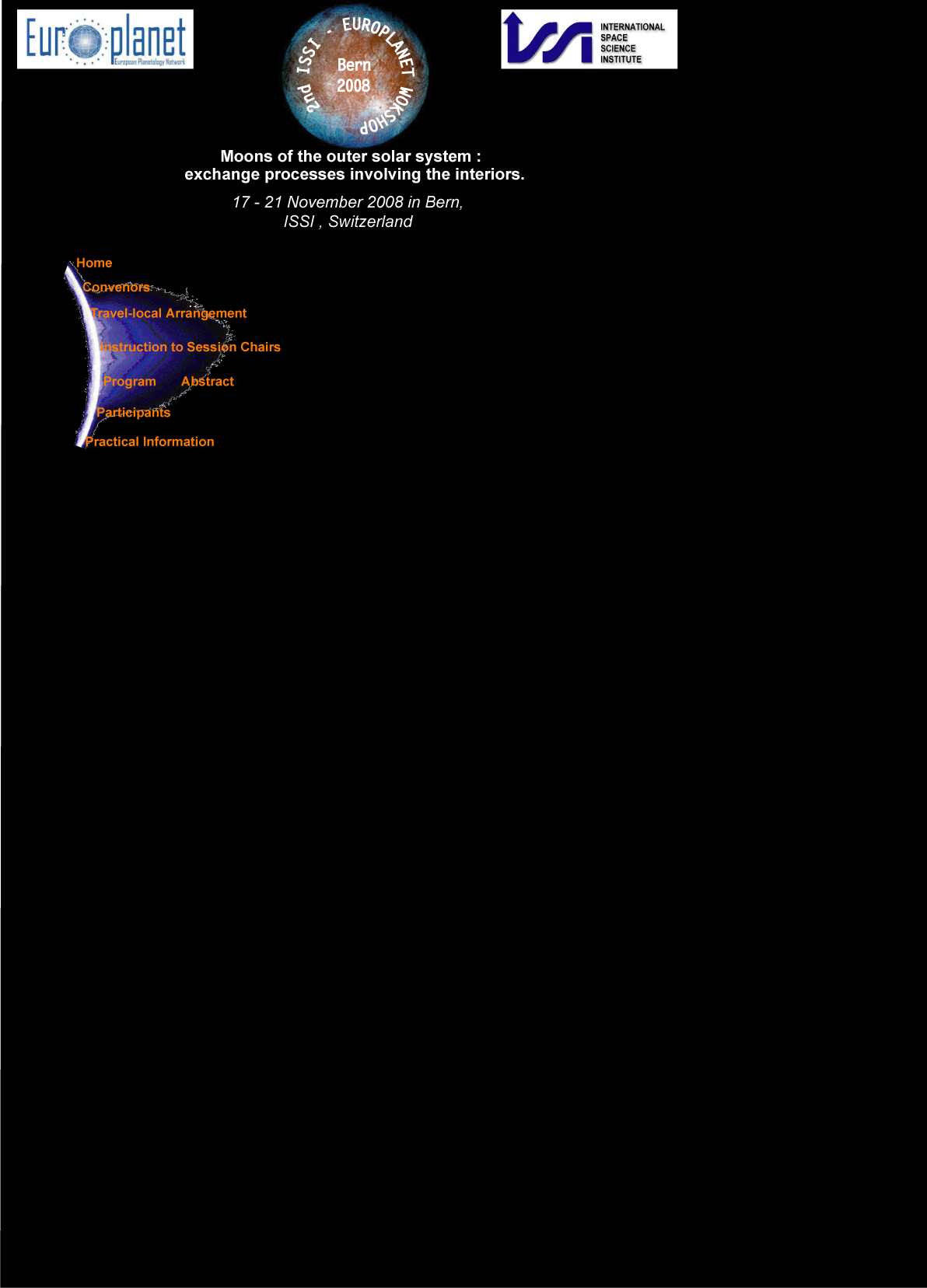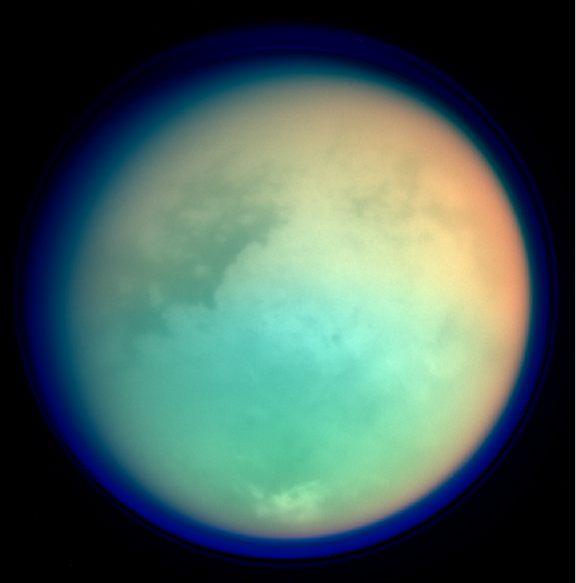


Convenors : M. Blanc, O. Grasset, A. Coustenis, H. Hussmann, T. Owen, R. Pappalardo, S. Sasaki, D. Torrini
Format/Purpose:
The purpose of this Workshop is to bring together a large community to a) present DATA (Observations and laboratory measurements), b) describe their ANALYSIS and c) discuss the IMPLICATIONS in terms of origin and evolution of the surfaces of the moons in that order. An exception is made for the ‘astrobiology and planetary protection part’ which is scheduled on Tuesday afternoon for practical reasons.
This organisation implies that some talks may appear similar on the basis of their titles but in fact they cover different aspects. For example, faults are described ‘geologically’ in the first part of the Workshop, interpreted in the second one (what are the models that can explain the facts?) and used in the last one as a fundamental basis in the study of the evolution of the Europa surface or of the problems it involves in term of planetary protection.
The workshop is divided into short talks about specific subjects (around 20-25 minutes) and longer talks for general reviews of a given topic (30-40 mn).
Sessions are followed by discussions.
The main topics of the workshop are listed below:
OBSERVATIONS/DATA from space and ground as well as laboratory work:
IMPLICATIONS:
9h30 Welcome ISSI / Europlanet Bonnet/Blanc
09h45 Introductive talk / Icy satellite overview T. Johnson
10h30 Coffee break
DATA/FACTS: Composition of the moons (L. Prockter)
10h45 Compositions of ices and volatiles in the Saturnian system : constraints from the Cassini-Huygens mission R. Lorenz
11h20 Composition of the icy moons in the jovian system from observations
T. McCord
11h55 Discussion
12h30 Lunch
DATA/FACTS: Surface characteristics – topography/morphology (R. Lopes)
14h00 Cryovolcanism in the outer solar system : an overview R. Lopes
14h35 The geology of Europa L. Prockter
15h10 Discussion
15h45 Coffee break
DATA/FACTS: Surface and atmosphere characteristics –specific bodies (A. Coustenis)
16h15 Enceladus E. Turtle
16h50 Geological features on Titan R. Jaumann
17h25 Discussion
18h00-18h15 End of session
Welcome Drink
DATA/FACTS: Physical constraints (N. Krupp)
08h30 The jovian environment N. Krupp
08h50 Saturn, Uranus and Neptune environments K. Khurana
09h10 Electromagnetically induced magnetic fields from within the
icy moons F. Neubauer
09h40 The gravity fields of the solar system satellites L. Iess
10h00 Discussion
10h30: Coffee break
DATA/FACTS: Physics and chemistry of ices and organics (W. Durham)
10h45 Rheology of icy materials under planetary conditions W. Durham
11h10 Spectroscopy of Planetary Ices in Support of Spacecraft
Missions B. Dalton
11h35 Radar investigation of icy surfaces W. Kofman
12h00 Instability of hydrates in planetary interiors D. Fortes
12h30 Lunch
DATA/FACTS: Physics and chemistry of ices and organics (W. Durham)
14h00 Tholins – a way to understand the organic complexity of Titan P. Coll
14h25 The chemistry of ices in the solar system J. Kargel
14h50 Discussion
15h45 - Coffee break
IMPLICATIONS: Exobiology, habitability and planetary protection (F. Raulin)
16h15 Planetary protection and the icy moons of the giants planets M. Viso
16h40 Habitability of Europa and Enceladus K Hand
17h05 Habitability of Titan F. Raulin
17h30 Discussion
18h00 End of session
ANALYSIS: Past and present dynamics of icy surfaces (G. Tobie)
08h45 Lithosphere dynamics: flexure and relaxation B. Giese
09h15 Geological mapping and interpretation of icy satellite surfaces L. Prockter
09h45 Cryovolcanism: exchanges between mantle and icy crusts G. Tobie
10h15 Coffee break
ANALYSIS: External processes: interactions with the atmosphere and the space environment (T. Cassidy/R. Wagner)
10h45 Analysis of Titan surface and atmosphere infrared data A. Coustenis
11h20 Space weathering and magnetospheric interactions T. Cassidy
11h45 Discussion
12h45 End of session
ANALYSIS: Internal processes: energy sources and dynamics (H. Hussman/T. Van Hoolst)
09h00 Rotation and libration of large icy satellites T. Van Hoolst
09h25 Tidal dissipation and orbital evolution of large satellites V. Lainey
09h50 Internal energy sources of outer planet satellites H. Hussmann
10h15 Convective motions within icy mantles C. Sotin
10h40: coffee break
ANALYSIS: Internal processes: energy sources and dynamics (H. Hussman/T. Van Hoolst)
11h00 Oceans in Icy Satellites F. Sohl - T. Spohn
11h30 Discussion
12h30 Lunch
ANALYSIS: External processes: interactions with the atmosphere and the space environment (T. Cassidy/R. Wagner)
14h00 Cratering and surface ages of icy satellites R. Wagner
14h25 Exchange processes between satellites and rings F. Postberg
14h50 Interactions between satellites and magnetospheres the outer
solar system M. Burger
15h15 - Coffee break
ANALYSIS: Past and present dynamics of icy surfaces (G. Tobie)
15h45 Surface reaction to seasonal variations in the case of Titan T. Tokano
16h15 Condensation and Dynamics of Ice Grains in Enceladus’ Plume J. Schmidt
16h45 Discussion
17h45 End of session
19h00 Dinner at the "Casino" restaurant
IMPLICATIONS: Origin of the moons (D. Turrini)
08h30 Initial conditions in circumplanetary nebulae A. Coradini
08h50 Formation of the regular satellites I. Mosqueira
09h15 Exogenous versus endogenous material: the capture of Triton and
irregular satellites D. Turrini
09h40 Discussion
10h10: Coffee break
IMPLICATIONS: Evolution of the moons (G. Schubert)
10h30 Early thermal evolution of small and mid sized icy moons D. Matson
10h55 Rhea and the diversity of outer planet icy satellites G. Schubert
11h20 Future exploration of the outer solar system J.-P Lebreton
11h45 Discussion
12h15 Lunch
13h30 Final discussion
16h00 End of the workshop
